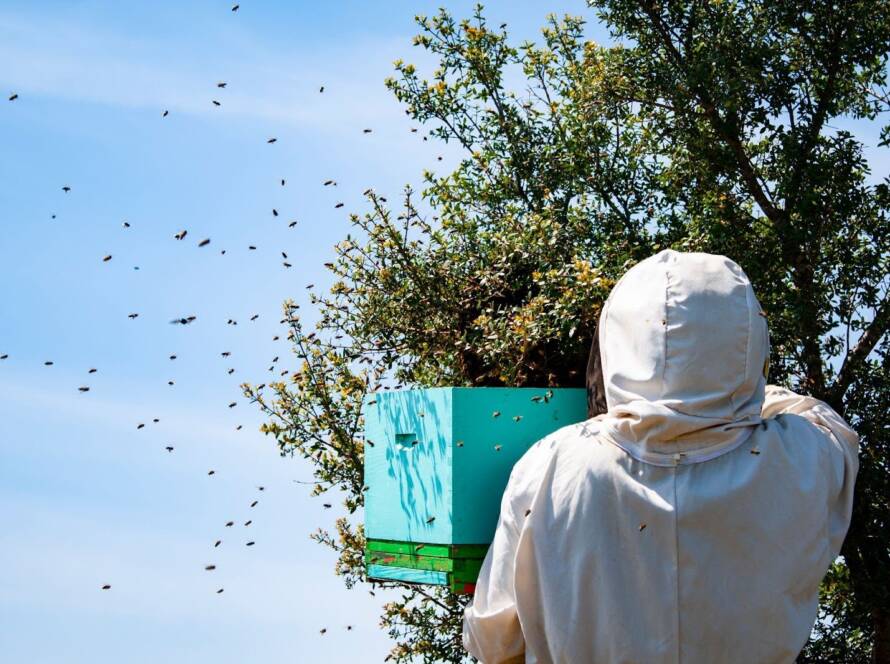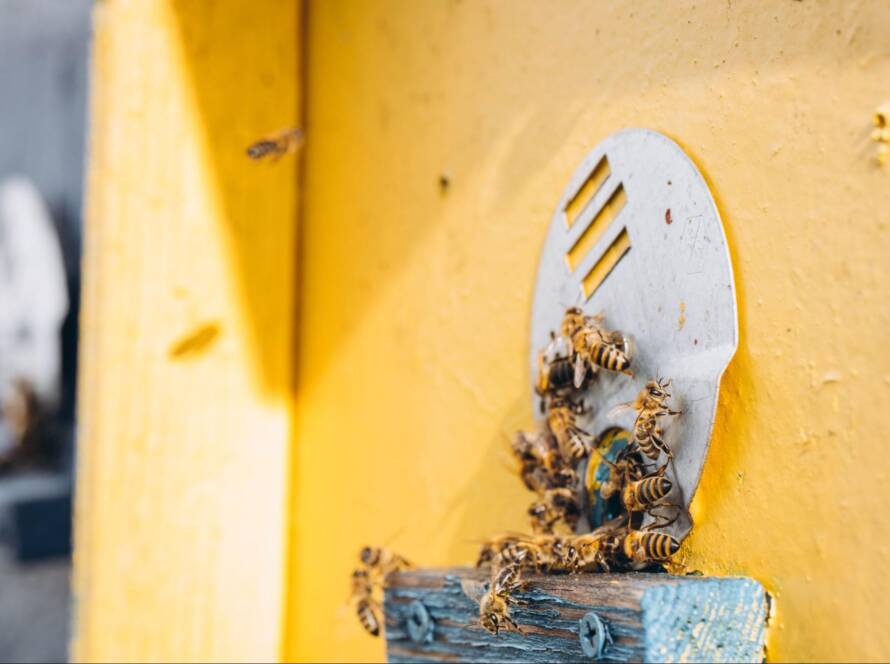Bees play a crucial role in our ecosystem, pollinating nearly 80% of flowering plants and supporting global food production. But when they build hives near homes, schools, or businesses, their presence can present real concerns—especially for those with allergies or children. While some might consider extermination as a quick fix, responsible bee control means finding a way to protect human safety without harming the environment or wiping out pollinator populations. This blog explores safe and eco-conscious insect control methods for effectively and ethically handling bee infestations.
Why Bee Control is Necessary for Certain Situations
Bees are vital pollinators, but they aren’t always welcome when their nests are too close for comfort. Understanding why bee control becomes essential helps strike a balance between environmental preservation and safety.
When Bees Become a Problem
Although bees are not naturally aggressive, they will defend their colonies if they feel threatened. This defensive behavior becomes particularly dangerous when hives are located in high-traffic areas, such as near doorways, playgrounds, or inside walls and attics. Swarms can also appear suddenly, overwhelming outdoor spaces.
Risks of Ignoring a Bee Infestation
Unchecked hives can grow to house thousands of bees. Large infestations may cause structural damage if they’ve nested in walls or roofs. More importantly, repeated stings—especially for those with allergies—can lead to medical emergencies.
Why Killing Bees Should Be the Last Resort
Bees are in decline globally due to the use of pesticides, habitat loss, and diseases. Killing them only worsens this issue. Sustainable bee control instead focuses on relocation and prevention, keeping people safe while allowing bees to continue their essential pollination work elsewhere.
Eco-Friendly Bee Control Methods That Work
The most effective way to address a bee infestation without harming the environment is through non-lethal, eco-friendly methods. These methods prioritize coexistence and conservation.
Live Removal and Relocation
Professional beekeepers and pest specialists trained in humane bee control can safely extract the hive and relocate the colony to a secure apiary. This method preserves the hive’s health and keeps the queen intact, allowing the colony to thrive elsewhere.
Using Smoke As a Calming Tool
Smoke doesn’t harm bees but temporarily disrupts their pheromonal communication. Smoke calms the hive and makes it easier for professionals to relocate it safely without aggressive behavior or injury to the bees.
Natural Repellents to Deter New Hives
Essential oils such as peppermint, citronella, and eucalyptus can deter bees from nesting. Spraying these oils in vulnerable areas, such as eaves or attics, can serve as a preventive measure. These substances don’t harm bees but gently redirect them elsewhere.
Bee Control and the Importance of Professional Help
Handling bees on your own can be dangerous and often ineffective. For effective and safe bee control, professional intervention is typically the most prudent and environmentally responsible option.
When to Call a Bee Specialist
If the hive is large, located in a wall void, chimney, or other difficult-to-access area, it’s time to call a pro. Professionals come with the gear and expertise to relocate bees without causing harm to you or the environment.
Qualifications to Look For
Choose companies or individuals with experience in live bee removal, not general pest extermination. Many eco-conscious pest control businesses partner with local beekeepers to ensure hives are appropriately relocated rather than destroyed.
Benefits of Expert Bee Control Services
Professional services ensure thorough hive removal, queen preservation, and long-term prevention. Many also provide repairs to seal up entry points and prevent re-infestation—further reducing the need for future intervention.
Sustainable Bee Control Solutions for Residential Areas
Bee infestations in residential neighborhoods require particular care to protect both people and pollinators. Thoughtful bee control methods can prevent escalation without resorting to extermination.
How Bees Enter Homes
Bees often gain access through rooflines, soffits, vents, or tiny gaps in siding. Once inside, they may build hives within walls or attics, which go unnoticed until buzzing or honey leaks become apparent.
Preventive Measures for Homeowners
Preventing a bee infestation starts with making your home less inviting to bees in the first place. These proactive steps can help reduce the likelihood of colonies forming near or inside your home.
Seal Any Cracks or Openings in Your Home’s Exterior
Bees can enter through surprisingly small gaps in siding, eaves, soffits, or window frames. Regularly inspect your home’s exterior and use caulk, foam, or weatherstripping to seal openings. These materials help block access to walls and attic spaces where bees commonly build nests.
Install Screens Over Vents and Chimney Openings
Vents, flues, and chimneys provide open pathways for bees to enter roof and wall cavities. Installing fine mesh screens over these openings keeps bees out while still allowing for proper airflow and ventilation.
Avoid Overly Fragrant Plants Near Entry Points
Certain flowering plants attract foraging bees due to their scent and nectar. While pollinator gardens are beneficial when placed correctly, avoid planting fragrant blooms near doors, windows, or vents where bees could wander indoors or begin nesting nearby.
What to Do if You Spot a Hive
Stay calm and keep a safe distance. Don’t attempt to spray or remove it yourself. Contact a bee control specialist immediately, especially if the hive is near a high-traffic area or inside a structure.
Bee Control Practices That Protect Pollinators
Ethical bee control doesn’t just deal with infestations—it also aims to ensure the survival of bees in safe, natural habitats. Here’s how you can contribute to the bigger picture.
Don’t Use Harmful Pesticides
Neonicotinoids and other insecticides commonly used in landscaping are deadly to bees—even in small amounts. Avoid chemical treatments, especially during blooming seasons when bees are actively pollinating.
Encourage Healthy Bee Habitats Elsewhere
Support pollinator health by planting wildflowers, herbs, and native plants away from structures. Build bee houses in safe corners of your yard to offer solitary bees alternative nesting sites.
Partnering With Local Beekeepers
Many urban and rural areas have beekeeper networks eager to rescue and rehome hives. Supporting their work not only provides a solution for your infestation but also strengthens the local ecosystem.
Legal and Ethical Environmental Considerations in Bee Control
Bee populations are protected or regulated in many areas. Knowing your rights and responsibilities helps ensure your bee control approach aligns with local regulations.
Laws Around Bee Removal
Some states and municipalities prohibit killing honey bees and mandate relocation instead. Always check with your local agriculture or environmental agency before taking action.
Environmental Impact of Irresponsible Removal
Destroying hives can disrupt the food chain, kill pollinators, and lead to contamination if honeycomb is left behind in structures. Ethical removal minimizes these impacts and helps restore ecological balance.
Making the Right Ethical Choice
By choosing bee control practices that prioritize live removal, you’re contributing to global pollinator health and biodiversity—one hive at a time.
Bee Control for Businesses and Commercial Properties
When bee infestations affect commercial properties, swift and safe action is vital—but it must be balanced with corporate responsibility toward environmental sustainability.
Challenges for Commercial Spaces
Warehouses, office buildings, schools, and restaurants are common targets for bee nesting. Large structures offer shelter, and nearby landscaping can attract foraging bees. The presence of employees, customers, or students raises the urgency of effective bee control.
Minimizing Disruption During Removal
Professional removal services often work outside regular business hours to ensure safe and discreet extraction. Temporary barriers and signage can help keep foot traffic away while the hive is removed.
Demonstrating Environmental Stewardship
Businesses that adopt eco-conscious pest control demonstrate a commitment to sustainability. Partnering with ethical bee control services can be a positive public relations opportunity, demonstrating to your community that your company prioritizes environmental well-being.
Post-Removal Care and Long-Term Bee Control Tips
Even after a successful removal, preventing future infestations requires a few smart steps. Ongoing vigilance is key to maintaining an environmentally friendly, bee-free property.
Clean and Seal the Area
After a hive is removed, it’s crucial to clean up all remaining honeycomb and scent trails. These remnants attract other bee colonies and pests. Once cleaned, seal the area thoroughly to prevent re-entry.
Schedule Routine Inspections
Having annual or biannual inspections by a bee control professional can catch early signs of bee activity. Quick action in the early stages can prevent larger infestations from taking hold.
Maintain Bee-Friendly Yet Safe Landscaping
Plant pollinator-friendly gardens away from buildings and entrances. Doing so supports bee populations while reducing the risk of proximity nesting. Avoid using synthetic fertilizers and pesticides in these areas.
The Future of Bee Control and Environmental Harmony
Bee control is evolving. With more public awareness about pollinator health and ecosystem preservation, pest management is shifting toward environmentally intelligent solutions. Homeowners, businesses, and communities must all embrace a mindset of bee control with care—handling infestations in ways that preserve the balance between human safety and nature’s most important pollinators. By taking an informed, compassionate approach, you’re not only resolving a local nuisance—you’re playing a part in protecting biodiversity on a global scale. The next time you see a hive where it shouldn’t be, remember: bee control isn’t just about removal—it’s about respect.
Need expert guidance? Explore more eco-conscious pest insights on our Thrash Pest Control blog for information on safe, humane hive removal. Together, we can protect your space—and the environment.



